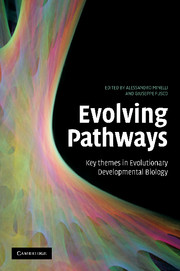Book contents
- Frontmatter
- Contents
- Contributors
- Preface
- Introduction: Pathways of change
- Part I Thinking about evolution by taking development on board
- 1 Evo-devo as a discipline
- 2 Making evolutionary predictions about the structure of development and morphology: beyond the neo-Darwinian and constraints paradigms
- 3 Conflicting hypotheses on the nature of mega-evolution
- 4 Prospects of evo-devo for linking pattern and process in the evolution of morphospace
- 5 The molecular biology underlying developmental evolution
- 6 Evo-devo's identity: from model organisms to developmental types
- Part II Evo-devo: methods and materials
- Part III Evolving diversity
- Part IV Evolving body features
- Index
- References
6 - Evo-devo's identity: from model organisms to developmental types
Published online by Cambridge University Press: 08 August 2009
- Frontmatter
- Contents
- Contributors
- Preface
- Introduction: Pathways of change
- Part I Thinking about evolution by taking development on board
- 1 Evo-devo as a discipline
- 2 Making evolutionary predictions about the structure of development and morphology: beyond the neo-Darwinian and constraints paradigms
- 3 Conflicting hypotheses on the nature of mega-evolution
- 4 Prospects of evo-devo for linking pattern and process in the evolution of morphospace
- 5 The molecular biology underlying developmental evolution
- 6 Evo-devo's identity: from model organisms to developmental types
- Part II Evo-devo: methods and materials
- Part III Evolving diversity
- Part IV Evolving body features
- Index
- References
Summary
EVO-DEVO'S IDENTITY
Evo-devo studies the evolution of development, and how changes in development influence phenotypic evolutionary change. The evolution of novelties and body plans are considered as the most distinctive research areas of evo-devo (Wagner 2000, 2001, Wagner et al. 2000, Müller and Newman 2005). Nevertheless, there seems to be little consensus about evo-devo's disciplinary identity. It has been regarded as a branch of developmental biology, part of evolutionary biology, a revision of evolutionary theory or an independent new synthetic discipline (Gilbert et al. 1996, Arthur 2000, 2002, 2004a, b, Hall 2000, Raff 2000, Wagner 2000, Robert et al. 2001, Gould 2002, Wilkins 2002, Baguñá and Garcia-Fernàndez 2003, Gilbert 2003, Kutschera and Niklas 2004, Amundson 2005, Müller and Newman 2005). Similarly, there has been skepticism about evo-devo's promise in both the literature (Wagner 2000, 2001, Richardson 2003, Wagner and Larsson 2003, Coyne 2005) and at meetings such as the one in 2006 in Venice, at which the present book was conceived.
Although various factors are at play, I think that current skepticism partly results from a failure to articulate evo-devo's conceptual foundation properly. This issue comes into focus when it is observed that the papers outlining evo-devo's research agenda almost exclusively link the promise of evo-devo to discovering general concepts and rules. Arthur (2002: 757), for example, expresses concern when he writes that we are currently in a situation ‘where it almost seems that anything goes, that is, any developmental gene, its expression pattern and the resultant ontogenetic trajectory can evolve in any way.
- Type
- Chapter
- Information
- Evolving PathwaysKey Themes in Evolutionary Developmental Biology, pp. 100 - 120Publisher: Cambridge University PressPrint publication year: 2008
References
- 5
- Cited by



